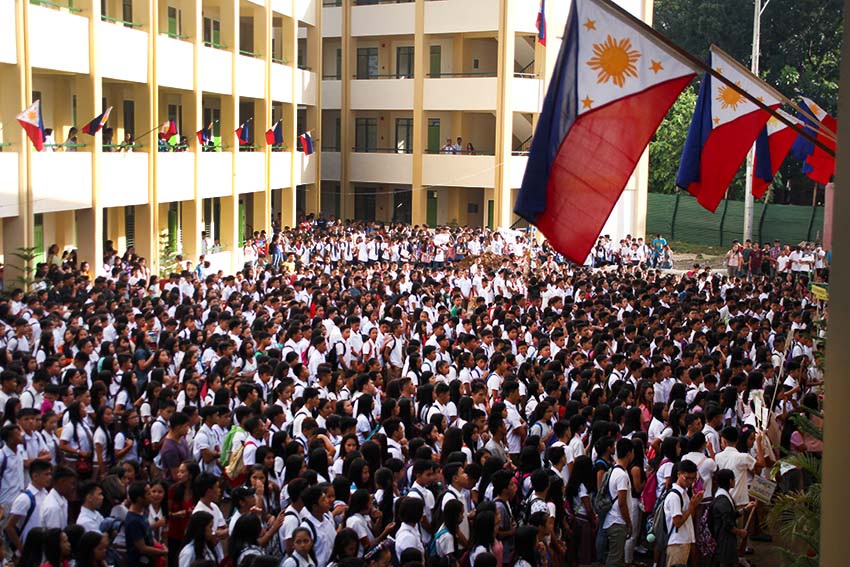
FIRST DAY OF SCHOOL. A total of 2,732 students of Mintal Comprehensive High School in Barangay Mintal, Davao City line up for the first flag ceremony of the school year during the opening of classes on Monday, June 5. (Paulo C. Rizal/davaotoday.com)
DAVAO CITY, Philippines — Having classes “under the mango tree” is a thing of the past, said Education Secretary Leonor Briones, Tuesday.
“We don’t have children anymore under the mango tree because there are school buildings beside the mango trees under our learning spaces and we have dealt with the shortages, this perceived shortage in as creative a manner,” said Briones said in a press briefing in Malacanang.
“The usual image of a child, of children having classes under the mango tree, of course, is long past. That happened during my time when I was still a student,” she said.
Briones said there is only 1.5 percent of classroom congestion in elementary schools and 1.9 percent for junior high school. However, Briones admitted that there is 6.56 percent shortage of classroom for senior high school, which the Department Secretary said they will resolve in two to three months.
“This is because (the) building construction is still ongoing. And we hope to resolve this,” she said.
‘DepEd failed to build more’
However, progressive lawmakers said DepEd failed to build more schools, especially for junior and senior high schools.
“With 36,492 public elementary schools and only 7,677 junior high schools, children in four or five elementary schools will have to cram themselves into a single high school when they graduate,” said ACT Teachers Partylist Rep. France Castro.
Castro added that while almost all barangays in the country have at least 1 elementary school, high schools are found mainly in urban areas and population centers only, at a ratio of 1 high school for every four to five barangays.
Rep. Antonio Tinio also from ACT Teachers Partylist agreed with Briones that the school shortage is more pronounced in senior high school (SHS), which DepEd started implementing last year.
But he said the government failed to build more schools to accommodate Grade 10 completers.
“Prior to the addition of Grades 11 and 12, the government did not launch a massive school building program to accommodate Grade 10 completers from public junior high schools, then expected to be from 1.2 million to 1.6 million,” he said.
Behind the target
Tinio said based on DepEd’s reports “the agency is lagging behind” its targets for classroom building.
He said DepEd only met 51.59 percent of its target units for 2014 until 2016.
“Of this number, it completed only 25,498 classrooms for senior high school or a little more than half of its target 49,294 units,” he said.
The lawmakers argued that more youth will not finish high school “if the government refuses to build and maintain more public schools, especially junior and senior high schools.”
“Per DepEd data, 3.4 million high school-age youth in School Year 2015-2016 were not enrolled in first to the fourth year. High school completion also declined in five years, with 1.9 million, or more than a fourth of the enrollees, dropping out in the middle of the school year,” they said.
Strategies
Meanwhile. Briones admitted that every year, the population of students keeps on increasing, making it hard to address the problem of congestion. She said she hopes with the new strategies they will be able to respond to the problem.
“Every year, it increases. We try to catch up and then you have a new batch of learners also, again to accommodate all needing classrooms,” she said.
To address classroom congestion, Briones said non-instructional rooms are being used now as instructional rooms, particularly in the National Capital Region.
“The problem and the challenge is the lack of buildable space. We have had congressmen in the Metro Manila area who don’t give us buildings at all because we don’t have space,” she said. Briones cited the case of Marikina City where nobody from the side of the government and private sector is willing to sell.
“During the early days of education, people were always quite happy to donate vast tracts of land, whether in the cities or in the provinces for, as sites for school buildings and name them in honor of their dynasties. Now, it does not happen anymore. No one wants to sell or to donate, much less donate to schools here in the urban centers,” Briones said.
To address the problem of congested classrooms, she said they are considering of building school communities outside Metro Manila. She also added they saw the possibility of building high-rise buildings.
Briones said this option will have heavy costs, citing the need for added safety measures for students of four-storey or five-storey buildings.
“(This) will have heavy cost implications and we will be needing the cooperation of the local government units and their support,” she said.
DepEd data shows there are currently 13,356,989 learners enrolled. Briones clarified that the total count does not include Region IX, which is yet to submit a report and the Autonomous Region in Muslim Mindanao. (davaotoday.com)









